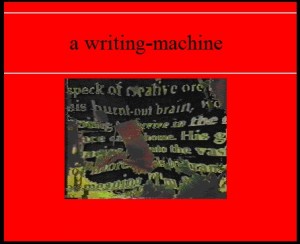Â
[Today's work of electronic literature: Grammatron]
 Maybe it is just a need caused by so long time spent in studying the “traditional” literature, but I feel I need a kind of history of Electronic Literature, or at least some time reference which allows me to collocate it a cultural and historic context. It sounds strange because Elecronic Literature is a very recent phenomenon, not older than 30. It is almost an adult, but it feels like a teen-ager. But anyway.
Maybe it is just a need caused by so long time spent in studying the “traditional” literature, but I feel I need a kind of history of Electronic Literature, or at least some time reference which allows me to collocate it a cultural and historic context. It sounds strange because Elecronic Literature is a very recent phenomenon, not older than 30. It is almost an adult, but it feels like a teen-ager. But anyway.
While I was looking for what was going on in the culture and society of those years, I happened to meet the Avant-Pop Movement, that is “a whole range of innovative formal strategies and narrative approaches modeled on more kinetic, dynamic, nonliterary forms of art”. This extract form the movement’s manifesto, included in their one and only anthology ”After tomorrow’s crash” gives an idea of what these neo-avangardist had in mind, that is a revolutionary idea of literature, which according to them should be completely unleashed from the previous artistic tradition and always searching for new means of communication and creation.
Moreover, many of the writers who took part in the movement come from different artistic backgrounds, like painting, music and photography. These “cross-genre impulses of Avant-Pop” give their writings something more, you feel that they are constrained in the small space of a page. They are in need of a sort of third dimension, you cannot just read them as you would read any other book. While reading I had the feeling of actually seeing what they were talking about, but some letters on a piece of paper are not enough to render this sensation. But when I saw that “Grammatron” by Mark America, probably my favourite among them, was later re-constructed, re-written and transformed into an Internet and hypertextual version,  I was absloutely delighted.
I’ll try to describe it and in some ways explain it, even if the best thing to do with works like this is spending some time navigating and exploring them. So, the basic structure is the one of what is commonly known as “hypertext”, that is a text with different links in it that the writer is invited to chose among so to create her own narrative path.
 [I must confess I find some difficulties in talking about it in literary terms, which anyway are the only "critique" tools that have been taught to me by far and that I am used to. One of the aims that I'd like this project to achieve is providing some useful terms, which should be ideally unbound from the previous print tradition. The only way to do it is giving it a try, so please "pardon my appearence", as many shopwindows say, and appreciate the efforts to ameliorate this unexplored field of our contemporary culture.] But anyways.
There are no substantial differences between the print and the web version of Grammatron in terms of character and events. What really changes is:
- first of all, the hypertext version is much longer than the other one, but what we experience are just chunks of text, one following another depending on where and when we click on their links. So basically you do not realize how many “pages” you have been reading, unless you think of a page as a web page.
- According to me, the hypertext version conveys much better the inner dynamics of the characters. [But they are not "characters", I need a better term...] For instance, Abe Golam – the main charactar [this is the first attempt of a better term, "character" and "avatar"], is a “legendary info-shaman, cracker of the sorcerer-code and creator of Grammatron and Nanoscript”. Grammatron itself is a creature of the Nanoscript code and “uses the language of desire’s own consciousness to disseminate the potential creative power that resides within the vast electrosphere”. How can all these things be just stuck in a printed page?
- The web version of Grammatron is featured with what Mark Amerika calls “a companion theory guide”. I have found his “Hypertextual Consciousness” particularly stimulating in terms of what we expect and get from reading an hypertext. Under the motto “I link therefore I am” he explores the mainfold aspects and psycholgical implications of dealing with this kind of texts. He investigates the viewpoint both of the reader, or “co-conspirator” and the writer, a creator of “textual space”.
My adivse is to experience it, I am sure it will be really inspiring. And moreover, it is the only way of becoming attentive consumers of the Internet without being trapped in its web.

